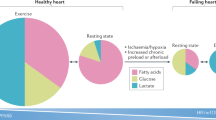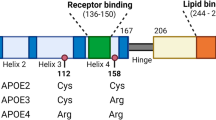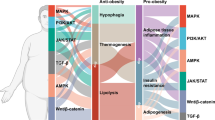Abstract
Obesity and the related disorders of dyslipidemia and diabetes (components of syndrome X) have become global health epidemics. Over the past decade, the elucidation of key regulators of energy balance and insulin signaling have revolutionized our understanding of fat and sugar metabolism and their intimate link. The three 'lipid-sensing' peroxisome proliferator–activated receptors (PPAR-α, PPAR-γ and PPAR-δ) exemplify this connection, regulating diverse aspects of lipid and glucose homeostasis, and serving as bona fide therapeutic targets. With molecular underpinnings now in place, new pharmacologic approaches to metabolic disease and new questions are emerging.
This is a preview of subscription content, access via your institution
Access options
Subscribe to this journal
Receive 12 print issues and online access
$209.00 per year
only $17.42 per issue
Buy this article
- Purchase on SpringerLink
- Instant access to full article PDF
Prices may be subject to local taxes which are calculated during checkout



Similar content being viewed by others
References
Stunkard, A., Foch, T. & Hrubec, Z. A twin study of human obesity. JAMA 256, 51–54 (1986).
Zhang, Y. et al. Positional cloning of the mouse obese gene and its human homologue. Nature 372, 425–432 (1994).
Tartaglia, L. et al. Identification and expression cloning of a leptin receptor OB-R. Cell 83, 1263–1271 (1995).
Seeley, R. & Woods, S. Monitoring of stored and available fuel by the CNS: implications for obesity. Nat. Rev. Neurosci. 4, 901–909 (2003).
Nakazato, M. et al. A role for ghrelin in the central regulation of feeding. Nature 409, 194–198 (2001).
Drazen, D. & Woods, S. Peripheral signals in the control of satiety and hunger. Curr. Opin. Clin. Nutr. Metab. Care 6, 621–629 (2003).
Batterham, R. et al. Gut hormone PYY3-36 physiologically inhibits food intake. Nature 418, 650–654 (2002).
Turton, M. et al. A role for glucagon-like peptide-1 in the central regulation of feeding. Nature 379, 69–72 (1996).
Bachman, E. et al. βAR signaling required for diet-induced thermogenesis and obesity resistance. Science 297, 843–845 (2002).
Wu, Z. et al. Mechanisms controlling mitochondrial biogenesis and respiration through the thermogenic coactivator PGC-1. Cell 98, 115–124 (1999).
Lin, J. et al. Transcriptional co-activator PGC-1α drives the formation of slow-twitch muscle fibres. Nature 418, 797–801 (2002).
Lowell, B. & Spiegelman, B. Towards a molecular understanding of adaptive thermogenesis. Nature 404, 652–660 (2000).
Enerback, S. et al. Mice lacking mitochondrial uncoupling protein are cold-sensitive but not obese. Nature 387, 90–94 (1997).
Fleury, C. et al. Uncoupling protein-2: a novel gene linked to obesity and hyperinsulinemia. Nat. Genet. 15, 269–272 (1997).
Gimeno, R.E. et al. Cloning and characterization of an uncoupling protein homolog: a potential molecular mediator of human thermogenesis. Diabetes 46, 900–906 (1997).
Boss, O. et al. Uncoupling protein-3: a new member of the mitochondrial carrier family with tissue-specific expression. FEBS Lett. 408, 39–42 (1997).
Vidal-Puig, A., Solanes, G., Grujic, D., Flier, J.S. & Lowell, B.B. UCP3: an uncoupling protein homologue expressed preferentially and abundantly in skeletal muscle and brown adipose tissue. Biochem. Biophys. Res. Commun. 235, 79–82 (1997).
Kopecky, J., Clarke, G., Enerback, S., Spiegelman, B. & Kozak, L.P. Expression of the mitochondrial uncoupling protein gene from the aP2 gene promoter prevents genetic obesity. J. Clin. Invest. 96, 2914–2923 (1995).
Clapham, J.C. et al. Mice overexpressing human uncoupling protein-3 in skeletal muscle are hyperphagic and lean. Nature 406, 415–418 (2000).
Li, B. et al. Skeletal muscle respiratory uncoupling prevents diet-induced obesity and insulin resistance in mice. Nat. Med. 6, 1115–1120 (2000).
Enerback, S. et al. Mice lacking mitochondrial uncoupling protein are cold-sensitive but not obese. Nature 387, 90–94 (1997).
Arsenijevic, D. et al. Disruption of the uncoupling protein-2 gene in mice reveals a role in immunity and reactive oxygen species production. Nat. Genet. 26, 435–439 (2000).
Vidal-Puig, A.J. et al. Energy metabolism in uncoupling protein 3 gene knockout mice. J. Biol. Chem. 275, 16258–16266 (2000).
Levine, J., Eberhardt, N. & Jensen, M. Role of nonexercise activity thermogenesis in resistance to fat gain in humans. Science 283, 212–214 (1999).
Ullrich, A. et al. Human insulin receptor and its relationship to the tyrosine kinase family of oncogenes. Nature 313, 756–761 (1985).
Ebina, Y. et al. The human insulin receptor cDNA: the structural basis for hormone-activated transmembrane signaling. Cell 40, 747–758 (1985).
Sun, X.J. et al. Structure of the insulin receptor substrate IRS-1 defines a unique signal transduction protein. Nature 352, 73–77 (1991).
Sun, X.J. et al. Role of IRS-2 in insulin and cytokine signaling. Nature 377, 173–177 (1995).
Accili, D. et al. Early neonatal death in mice homozygous for a null allele of the insulin receptor gene. Nature Genet. 12, 106–109 (1996).
Michael, M. et al. Loss of insulin signaling in hepatocytes leads to severe insulin resistance and progressive hepatic dysfunction. Mol. Cell 6, 87–97 (2000).
Kulkarni, R. et al. Tissue-specific knockout of the insulin receptor in pancreatic β cells creates an insulin secretory defect similar to that in type 2 diabetes. Cell 96, 329–339 (1999).
Bruning, J. et al. A muscle-specific insulin receptor knockout exhibits features of the metabolic syndrome of NIDDM without altering glucose tolerance. Mol. Cell 2, 559–569 (1998).
Fernandez, A. et al. Functional inactivation of the IGF-1 and insulin receptors in skeletal muscle causes type 2 diabetes. Genes Dev. 15, 1926–1934 (2001).
Mu, J., Brozinick, J., Valladares, O., Bucan, M. & Birnbaum, M. A role for AMP-activated protein kinase in contraction- and hypoxia-regulated glucose transport in skeletal muscle. Mol. Cell 7, 1085–1094 (2001).
Bluher, M., Kahn, B. & Kahn, R. Extended longevity in mice lacking the insulin receptor in adipose tissue. Science 299, 572–574 (2003).
Lauro, D. et al. Impaired glucose tolerance in mice with a targeted impairment of insulin action in muscle and adipose tissue. Nat. Genet. 20, 294–298 (1998).
Guerra, C. et al. Brown adipose tissue-specific insulin receptor knockout shows a diabetic phenotype without insulin resistance. J. Clin. Invest. 108, 1205–1213 (2001).
Tamemoto, H. et al. Insulin resistance and growth retardation in mice lacking insulin receptor substrate-1. Nature 372, 182–186 (1994).
Withers, D. et al. Disruption of IRS-2 causes type 2 diabetes in mice. Nature 391, 900–904 (1998).
Shulman, G.I. Cellular mechanisms of insulin resistance. J. Clin. Invest. 106, 171–176 (2000).
Dresner, A. et al. Effects of free fatty acids on glucose transport and IRS-1-associated phosphatidylinositol 3-kinase activity. J. Clin. Invest. 103, 253–259 (1999).
Perseghin, G. et al. Intramyocellular triglyceride content is a determinant of in vivo insulin resistance in humans: a 1H–13C nuclear magnetic resonance spectroscopy assessment in offspring of type 2 diabetic parents. Diabetes 48, 1600–1606 (1999).
Petersen, K.F. et al. Mitochondrial dysfunction in the elderly: possible role in insulin resistance. Science 300, 1140–1142 (2003).
Kim, J.K. et al. Tissue-specific overexpression of lipoprotein lipase causes tissue-specific insulin resistance. Proc. Natl. Acad. Sci. USA 98, 7522–7527 (2001).
Yu, C. et al. Mechanism by which fatty acids inhibit insulin activation of insulin receptor substrate-1 (IRS-1)-associated phosphatidylinositol 3-kinase activity in muscle. J. Biol. Chem. 277, 50230–50236 (2002).
Issemann, I. & Green, S. Activation of a member of the steroid hormone receptor superfamily by peroxisome proliferators. Nature 347, 645–650 (1990).
Dreyer, C. et al. Control of the peroxisomal β-oxidation pathway by a novel family of nuclear hormone receptors. Cell 68, 879–887 (1992).
Kliewer, S.A. et al. Differential expression and activation of a family of murine peroxisome proliferator-activated receptors. Proc. Natl. Acad. Sci USA 91, 7355–7359 (1994).
Chawla, A., Repa, J.J., Evans, R.M. & Mangelsdorf, D.J. Nuclear receptors and lipid physiology: opening the X-files. Science 294, 1866–1870 (2001).
Rosen, E.D., Walkey, C.J., Puigserver, P. & Spiegelman, B.M. Transcriptional regulation of adipogenesis. Genes Dev. 14, 1293–1307 (2000).
Tontonoz, P., Hu, E. & Spiegelman, B.M. Stimulation of adipogenesis in fibroblasts by PPARγ2, a lipid-activated transcription factor. Cell 79, 1147–1156 (1994).
Barak, Y. et al. PPARγ is required for placental, cardiac, and adipose tissue development. Mol. Cell 4, 585–595 (1999).
Rosen, E.D. et al. PPARγ is required for the differentiation of adipose tissue in vivo and in vitro. Mol. Cell 4, 611–617 (1999).
Kubota, N. et al. PPARγ mediates high-fat diet-induced adipocyte hypertrophy and insulin resistance. Mol. Cell 4, 597–609 (1999).
Agarwal, A.K. & Garg, A. A novel heterozygous mutation in peroxisome proliferator-activated receptor-γ gene in a patient with familial partial lipodystrophy. J. Clin. Endocrinol. Metab. 87, 408–411 (2002).
Hegele, R.A., Cao, H., Frankowski, C., Mathews, S.T. & Leff, T. PPARG F388L, a transactivation-deficient mutant, in familial partial lipodystrophy. Diabetes 51, 3586–3590 (2002).
Savage, D.B. et al. Human metabolic syndrome resulting from dominant-negative mutations in the nuclear receptor peroxisome proliferator-activated receptor-γ. Diabetes 52, 910–917 (2003).
Wu, Z. et al. Cross-regulation of C/EBP and PPARγ controls the transcriptional pathway of adipogenesis and insulin sensitivity. Mol. Cell 3, 151–158 (1999).
Rosen, E.D. et al. C/EBPalpha induces adipogenesis through PPARγ: a unified pathway. Genes Dev. 16, 22–26 (2002).
Forman, B.M. et al. Deoxy-delta 12, 14-prostaglandin J2 is a ligand for the adipocyte determination factor PPARγ. Cell 83, 803–812 (1995).
Lehmann, J.M. et al. An antidiabetic thiazolidinedione is a high affinity ligand for peroxisome proliferator-activated receptor γ (PPARγ). J. Biol. Chem. 270, 12953–12956 (1995).
Yamauchi, T. et al. The mechanisms by which both heterozygous peroxisome proliferator-activated receptor γ (PPARγ) deficiency and PPARγ agonist improve insulin resistance. J. Biol. Chem. 276, 41245–41254 (2001).
Guan, H.-P. et al. A futile metabolic cycle activated in adipocytes by antidiabetic agents. Nat. Med. 8, 1122–1128 (2002).
Peraldi, P., Xu, M. & Spiegelman, B.M. Thiazolidinediones block tumor necrosis factor-α-induced inhibition of insulin signaling. J. Clin. Invest. 100, 1863–1869 (1997).
Steppan, C.M. et al. The hormone resistin links obesity to diabetes. Nature 409, 307–312 (2001).
Rajala, M.W., Obici, S., Scherer, P.E. & Rossetti, L. Adipose-derived resistin and gut-derived resistin-like molecule-β selectively impair insulin action on glucose production. J. Clin. Invest. 111, 225–300 (2003).
Combs, T.P., Berg, A.H., Obici, S., Scherer, P.E. & Rossetti, L. Endogenous glucose production is inhibited by the adipose-derived protein Acrp30. J. Clin. Invest. 108, 1875–1881 (2001).
Berg, A.H., Combs, T.P., Du, X., Brownlee, M. & Scherer, P.E. The adipocyte-secreted protein Acrp30 enhances hepatic insulin action. Nat. Med. 7, 947–953 (2001).
Yamauchi, T. et al. The fat-derived hormone adiponectin reverses insulin resistance associated with both lipoatrophy and obesity. Nat. Med. 7, 941–946 (2001).
Yamauchi, T. et al. Adiponectin stimulates glucose utilization and fatty-acid oxidation by activating AMP-activated protein kinase. Nat. Med. 8, 1288–1295 (2002).
Yamauchi, T. et al. Cloning of adiponectin receptors that mediate antidiabetic metabolic effects. Nature 423, 762–769 (2003).
Ribon, V., Johnson, J.H., Camp, H.S. & Saltiel, A.R. Thiazolidinediones and insulin resistance: peroxisome proliferator activated receptor γ activation stimulates expression of the CAP gene. Proc. Natl. Acad. Sci. USA 95, 14751–14756 (1998).
Burant, C.F. et al. Troglitazone action is independent of adipose tissue. J. Clin. Invest. 100, 2900–2908 (1997).
Chao, L. et al. Adipose tissue is required for the antidiabetic, but not for the hypolipidemic, effect of thiazolidinediones. J. Clin. Invest. 106, 1221–1228 (2000).
Gavrilova, O. et al. Liver peroxisome proliferator-activated receptor γ contributes to hepatic steatosis, triglyceride clearance, and regulation of body fat mass. J. Biol. Chem. 278, 34268–34276 (2003).
Kim, J.K. et al. Differential effects of rosiglitazone on skeletal muscle and liver insulin resistance in A-ZIP/F-1 fatless mice. Diabetes 52, 1311–1318 (2003).
Miles, P.D., Barak, Y., He, W., Evans, R.M. & Olefsky, J.M. Improved insulin-sensitivity in mice heterozygous for PPAR-γ deficiency. J. Clin. Invest. 105, 287–292 (2000).
Berger, J.P. et al. Distinct properties and advantages of a novel peroxisome proliferator-activated protein γ selective modulator. Mol. Endocrinol. 17, 662–676 (2003).
Rangwala, S.M. et al. Genetic modulation of PPARg phosphorylation regulates insulin sensitivity. Dev. Cell 5, 657–663 (2003).
Ristow, M., Muller-Wieland, D., Pfeiffer, A., Krone, W. & Kahn, R. Obesity associated with a mutation in a genetic regulator of adipocyte differentiation. N. Engl. J. Med. 339, 953–959 (1998).
Matsusue, K. et al. Liver-specific disruption of PPARγ in leptin-deficient mice improves fatty liver but aggravates diabetic phenotypes. J. Clin. Invest. 111, 737–747 (2003).
He, W. et al. Adipose-specific peroxisome proliferator-activated receptor γ knockout causes insulin resistance in fat and liver but not in muscle. Proc. Natl. Acad. Sci. USA 100, 15712–15717 (2003).
Koutnikova, H. et al. Compensation by the muscle limits the metabolic consequences of lipodystrophy in PPAR γ hypomorphic mice. Proc. Natl. Acad. Sci. USA 100, 14457–14462 (2003).
Hevener, A.L. et al. Muscle-specific Pparg deletion causes insulin resistance. Nat Med. 9, 1491–1497 (2003).
Norris, A.W. et al. Muscle-specific PPARγ-deficient mice develop increased adiposity and insulin resistance but respond to thiazolidinediones. J. Clin. Invest. 112, 608–618 (2003).
Reddy, J.K. & Hashimoto, T. Peroxisomal β-oxidation and peroxisome proliferator-activated receptor α: an adaptive metabolic system. Annu. Rev. Nutr. 21, 193–230 (2001).
Kersten, S. et al. Peroxisome proliferator-activated receptor α mediates the adaptive response to fasting. J. Clin. Invest. 103, 1489–1498 (1999).
Guerre-Millo, M. et al. Peroxisome proliferator-activated receptor α activators improve insulin sensitivity and reduce adiposity. J. Biol. Chem. 275, 16638–16642 (2000).
Chou, C.J. et al. WY14,643, a peroxisome proliferator-activated receptor α (PPARα) agonist, improves hepatic and muscle steatosis and reverses insulin resistance in lipoatrophic A-ZIP/F-1 mice. J. Biol. Chem. 277, 24484–24489 (2002).
Kim, H. et al. Peroxisome proliferator-activated receptor-α agonist treatment in a transgenic model of type 2 diabetes reverses the lipotoxic state and improves glucose homeostasis. Diabetes 52, 1770–1778 (2003).
Peters, J.M. et al. Growth, adipose, brain, and skin alterations resulting from targeted disruption of the mouse peroxisome proliferator-activated receptor β(δ). Mol. Cell. Biol. 20, 5119–5128 (2000).
Barak, Y. et al. Effects of peroxisome proliferator-activated receptor δ on placentation, adiposity, and colorectal cancer. Proc. Natl. Acad. Sci. USA 99, 303–308 (2002).
Oliver, W.R. et al. A selective peroxisome proliferator-activated receptor δ agonist promotes reverse cholesterol transport. Proc. Natl. Acad. Sci. USA 98, 5306–5311 (2001).
Wang, Y.-X. et al. Peroxisome-proliferator-activated receptor δ activates fat metabolism to prevent obesity. Cell 113, 159–170 (2003).
Puigserver, P. et al. A cold-inducible coactivator of nuclear receptors linked to adaptive thermogenesis. Cell 92, 829–839 (1998).
Muoio, D.M. et al. Fatty acid homeostasis and induction of lipid regulatory genes in skeletal muscles of peroxisome proliferator-activated receptor (PPAR) α knock-out mice. Evidence for compensatory regulation by PPAR δ. J. Biol. Chem. 277, 26089–26097 (2002).
Dressel, U. et al. The peroxisome proliferator-activated receptor β/δ agonist, GW501516, regulates the expression of genes involved in lipid catabolism and energy uncoupling in skeletal muscle cells. Mol. Endocrinol. 17, 2477–2493 (2003).
Luquet, S. et al. Peroxisome proliferator-activated receptor δ controls muscle development and oxidative capability. FASEB J. 17, 2299–2301 (2003).
Tanaka, T. et al. Activation of peroxisome proliferator-activated receptor β induces fatty acid β-oxidation in skeletal muscle and attenuates metabolic syndrome. Proc. Natl. Acad. Sci. USA 100, 15924–15929 (2003).
Gupta, R. et al. Activation of nuclear hormone receptor peroxisome proliferator-activated receptor-δ accelerates intestinal adenoma growth. Nat. Med. 10, 245–247 (2004).
Saez, E. et al. Activators of the nuclear receptor PPARγ enhance colon polyp formation. Nat. Med. 4, 1058–1061 (1998).
Sarraf, P. et al. Differentiation and reversal of malignant changes in colon cancer through PPARγ. Nat. Med. 4, 1046–1052 (1998).
Lefebvre, A.-M. et al. Activation of the peroxisome proliferator-activated receptor γ promotes the development of colon tumors in C57BL/6J-APCMin/+ mice. Nat. Med. 4, 1053–1057 (1998).
Lee, C.H. et al. Transcriptional repression of atherogenic inflammation: modulation by PPARδ. Science 302, 453–457 (2003).
Ricote, M., Valledor, A.F. & Glass, C.K. Decoding transcriptional programs regulated by PPARs and LXRs in the macrophage: effects on lipid homeostasis, inflammation, and atherosclerosis. Arterioscler. Thromb. Vasc. Biol. 24, 230–239 (2004).
Acknowledgements
We thank R. Yu and W. He for critical reading of this manuscript, J. Simon for graphic artwork, and L. Ong and E. Stevens for administrative assistance. R.M.E. is an Investigator of the Howard Hughes Medical Institute at the Salk Institute for Biological Studies, and March of Dimes Chair in Molecular and Developmental Biology. G.D.B. is supported by National Institutes of Health Public Health Services Grant CA09370-23. This work was supported by the Howard Hughes Medical Institute, the Hilblom Foundation and grant U19DK62434 from the National Institutes of Health Nuclear Receptor Signaling Atlas orphan receptor program. We apologize to our colleagues that many primary references could not be included because of space limitations.
Author information
Authors and Affiliations
Ethics declarations
Competing interests
The authors declare no competing financial interests.
Rights and permissions
About this article
Cite this article
Evans, R., Barish, G. & Wang, YX. PPARs and the complex journey to obesity. Nat Med 10, 355–361 (2004). https://doi.org/10.1038/nm1025
Published:
Issue Date:
DOI: https://doi.org/10.1038/nm1025



